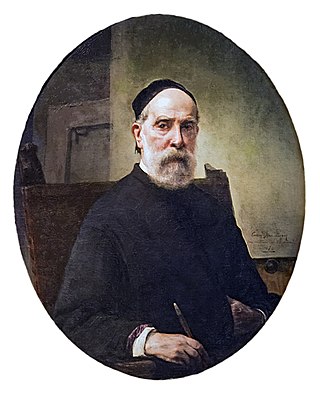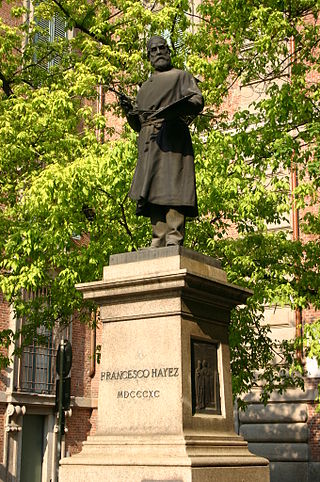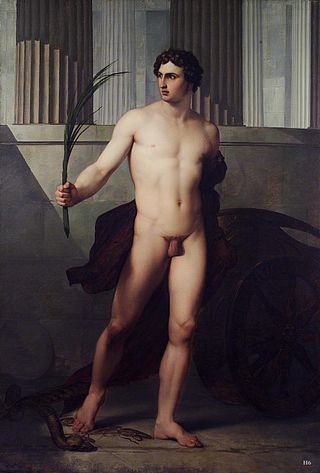
Alessandro Francesco Tommaso Antonio Manzoni was an Italian poet, novelist and philosopher. He is famous for the novel The Betrothed (1827), generally ranked among the masterpieces of world literature. The novel is also a symbol of the Italian Risorgimento, both for its patriotic message and because it was a fundamental milestone in the development of the modern, unified Italian language. Manzoni also contributed to the stabilization of the modern Italian language and helped to ensure linguistic unity throughout Italy. He was an influential proponent of Liberal Catholicism in Italy. His work and thinking has often been contrasted with that of his younger contemporary Giacomo Leopardi by critics.

Francesco Hayez was an Italian painter. He is considered one of the leading artists of Romanticism in mid-19th-century Milan, and is renowned for his grand historical paintings, political allegories, and portraits.

Galeazzo Maria Sforza was the fifth Duke of Milan from 1466 until 1476. He was notorious for being lustful, cruel, and tyrannical.

The Pinacoteca di Brera is the main public gallery for paintings in Milan, Italy. It contains one of the foremost collections of Italian paintings from the 13th to the 20th century, an outgrowth of the cultural program of the Brera Academy, which shares the site in the Palazzo Brera.
Gerolamo Olgiati was a government official in Milan and one of the assassins of Galeazzo Maria Sforza, the Duke of Milan, along with Giovanni Andrea Lampugnani and Carlo Visconti.

Francesco Sabatelli was an Italian painter.

Elena Clara Antonia Carrara Spinelli was an Italian woman of letters and backer of the Risorgimento, usually known by her married name of countess Clara Maffei or Chiarina Maffei.

The Museum of the Risorgimento, located in the 18th-century Milanese Palazzo Moriggia, houses a collection of objects and artworks which illustrate the history of Italian unification from Napoleon's Italian campaign of 1796 to the annexation of Rome in 1870. The city of Milan played a key role in the process, most notably on the occasion of the 1848 uprising against the Austrians known as the Five Days of Milan.

The Galleria d'Arte Moderna is a modern art museum in Milan, in Lombardy in northern Italy. It is housed in the Villa Reale, at Via Palestro 16, opposite the Giardini Pubblici Indro Montanelli. The collection consists largely of Italian and European works from the eighteenth to the twentieth centuries.

Francesco Barzaghi (1839–1892) was an Italian sculptor.

The Sanvitale conspiracy was a plot to assassinate Ranuccio I Farnese, Duke of Parma and Piacenza, and members of his family at the baptism of his new-born son Alessandro in 1611. The conspiracy may also be referred to in Italian as the congiura dei feudatari, "conspiracy of the feudal lords", or as the congiura del 1611, "conspiracy of 1611".

Alessandro Pieroni was an Italian architect and painter. He was active mainly in a Mannerist style, working for the courts of Grandukes Francesco I and Ferdinando I de' Medici, Grand Duke of Tuscany.

The Victorious Athlete or The Triumphant Athlete is an oil-on-canvas painting by the Italian artist Francesco Hayez, from 1813. It is held in the Accademia di San Luca, in Rome.

Self-Portrait Aged 71 is an 1862 oil-on-canvas painting by the Italian artist Francesco Hayez. The Uffizi had been requesting a self-portrait from him since 1858 via Andrea Appiani's daughter-in-law Giuseppina Appiani Strigelli and it finally arrived in 1863. It is still in the Uffizi's Vasari Corridor.

Pietro Rossi is an oil-on-canvas painting created in 1818–1820 by the Italian artist Francesco Hayez, now in the San Fiorano collection in Milan. A copy is in the Pinacoteca di Brera, also in Milan. Both show Pietro Rossi, accepting an invitation from Francesco Dandolo via a messenger to take command of the Venetian resistance to the expansionist Scaligeri. The work links a heroic past event to contemporary events and a Romantic sensitivity, as in historical novels of the same period such as Alessandro Manzoni's 1840 The Betrothed.

Portrait of Countess Antonietta Negroni Prati Morosini as a Child is an 1858 oil-on-canvas portrait by the Italian artist Francesco Hayez, commissioned by the subject's father Alessandro Negroni Prati Morosini. It is now in the Galleria d'Arte Moderna, in Milan, to which it was given in 1935 by Anna Cristina del Mayno Casati.

Portrait of Alessandro Manzoni is an 1841 oil-on-canvas portrait of Alessandro Manzoni by the Italian painter Francesco Hayez, now in the Pinacoteca di Brera. It was commissioned in 1840 by Manzoni's second wife countess Teresa Borri Stampa and his son Stefano. After fifteen sittings the painter completed the work on 26 June 1841. Eight years later Teresa commissioned a portrait of herself by the same artist.

Portrait of Teresa Manzoni Stampa Borri is an 1849 oil-on-canvas painting by the Italian artist Francesco Hayez, now in the Pinacoteca di Brera in Milan, to which it was given in 1900 by Stefano Stampa, the subject's son by her first marriage. She had also commissioned Portrait of Alessandro Manzoni from Hayez, showing her second husband, also in the Brera.
Cola Montano, also known as Nicola Capponi, was an Italian writer and humanist scholar who helped incite the Congiura dei Lampugnani or Conspiracy of the Lampugnani that succeeded in murdering the Duke of Milan, Galeazzo Maria Sforza. While not present at the murder, Cola Montano was captured by the Lorenzo de' Medici government of Tuscany, and hanged from a window in the Bargello.
Agostino Lampugnani was an Italian Benedictine monk and Baroque writer.
















